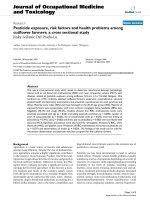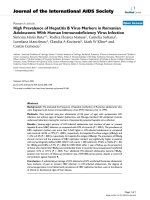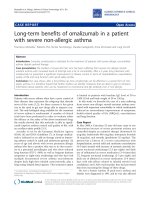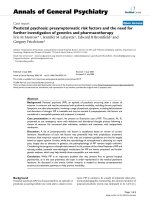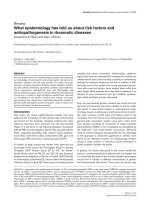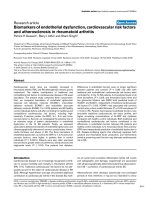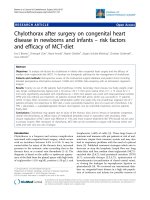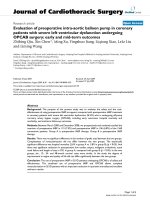Gender-related differences in cardiometabolic risk factors and lifestyle behaviors in treatment-seeking adolescents with severe obesity
Bạn đang xem bản rút gọn của tài liệu. Xem và tải ngay bản đầy đủ của tài liệu tại đây (522.98 KB, 8 trang )
Barstad et al. BMC Pediatrics (2018) 18:61
/>
RESEARCH ARTICLE
Open Access
Gender-related differences in
cardiometabolic risk factors and lifestyle
behaviors in treatment-seeking adolescents
with severe obesity
Lisa Ha Barstad1, Pétur B. Júlíusson1,2, Line Kristin Johnson1, Jens Kristoffer Hertel1, Samira Lekhal1
and Jøran Hjelmesæth1,3*
Abstract
Background: Obesity during adolescence is associated with cardiovascular mortality in adulthood. The adverse
obesity-related cardiometabolic risk profile is already observed in adolescence. We aimed to examine possible
gender differences in cardiometabolic risk factors and lifestyle behaviors among adolescents with severe obesity,
hypothesizing that boys would have both a higher prevalence of the metabolic syndrome as well as less healthy
lifestyle behaviors than girls.
Methods: Cross-sectional study of treatment-seeking adolescents with severe obesity who attended the Morbid
Obesity Centre at Vestfold Hospital Trust and who were consecutively enrolled in the Vestfold Register of Obese
Children between September 2009 and September 2015. A total of 313 adolescents aged 12 to 18 years were
recruited, whereof 268 subjects (49% boys) completed a food and activity frequency questionnaire and were
included in the analysis.
Results: Mean (SD) age, BMI and BMI SDS were 15 (1.6) years, 38.6 (5.9) kg/m2 and 3.5 (0.6). Levels of LDL
cholesterol, fasting insulin and glucose and diastolic blood pressure (DBP) did not differ between genders.
Compared to girls, boys had significantly higher triglycerides (p = 0.037) and systolic blood pressure (SBP)
(p = 0.003), as well as lower HDL cholesterol (p = 0.002). The metabolic syndrome was present in 27% of the
boys and 19% of the girls (p = 0.140), and the prevalence of high DBP, dyslipidemia and dysglycemia also did
not differ significantly between genders. The prevalence of high SBP was higher in boys than in girls (19% vs.
9%, p = 0.021). Gender was associated with a number of lifestyle habits, as a larger proportions of boys had
higher screen time (p = 0.032), more regular breakfast eating (p = 0.023), higher intake of sugar sweetened
soda (p = 0.036), and lower intake of vegetables than girls (p = 0.011). By contrast, physical activity level and
intake of fruit and berries did not differ between genders.
Conclusions: Male treatment-seeking adolescents with severe obesity had a more unfavorable set of
metabolic and behavioral risk factors for cardiovascular disease than girls. Our results indicate that lifestyle
behavioral markers should be thoroughly assessed in both genders, and possible gender-related differences in
risk profile should be taken into account in future treatment programs.
Keywords: Severe obesity, Gender differences, Lifestyle behavior, Metabolic syndrome, Cardiovascular risk factor,
Cardiovascular disease
* Correspondence:
1
Morbid Obesity Centre, Vestfold Hospital Trust, Box 2168, 3103 Tønsberg,
Norway
3
Department of Endocrinology, Morbid Obesity and Preventive Medicine,
Institute of Clinical Medicine, University of Oslo, Oslo, Norway
Full list of author information is available at the end of the article
© The Author(s). 2018 Open Access This article is distributed under the terms of the Creative Commons Attribution 4.0
International License ( which permits unrestricted use, distribution, and
reproduction in any medium, provided you give appropriate credit to the original author(s) and the source, provide a link to
the Creative Commons license, and indicate if changes were made. The Creative Commons Public Domain Dedication waiver
( applies to the data made available in this article, unless otherwise stated.
Barstad et al. BMC Pediatrics (2018) 18:61
Background
Cardiovascular diseases (CVD) are the leading cause of
mortality in both men and women.
Importantly, men have a 3–4-fold higher risk of an
acute coronary event below age 60 than women [1],
although the prevalence of ischemic heart disease in
younger women is increasing [2].
During the last 30 years, the prevalence of overweight
and obesity in children has increased to alarming proportions in many Western countries, with obesity currently affecting one-fifth of US adolescents aged 12 to
19 years [3, 4]. Obesity during the teen years is not only
a psychosocial burden, but is also related to increased
mortality in middle age from CVD and shortened life expectancy [5, 6]. The adverse cardiometabolic risk profile
related to obesity is observed in early adolescence and
even in early childhood [7–11], and cardiometabolic risk
factors are more prevalent with the increasing degree of
obesity in adolescents, particularly in boys [9, 10, 12].
Furthermore, adolescent boys tend to have larger
abdominal fat deposits than girls, a condition associated
with hypertension, dyslipidemia and dysglycemia [13].
A number of studies have shown that unhealthy lifestyle behaviors such as low physical activity level, high
screen time, skipping breakfast, high intake of sugarsweetened beverages (SSB) and low intake of fruits and
vegetables are related to obesity and cardiometabolic risk
factors in children and adolescents, and with CVD in
adults [14–23]. However, the causes and consequences
of obesity in adolescence differ between the genders due
to biological and behavioral differences [24–26]. Thus,
there is a need for a clearer focus on gender-related differences within the field of adolescent obesity. Considering that adolescent girls may be more likely to modify
their diet to obtain weight control than boys [27], and
boys have a more disadvantageous fat distribution after
puberty, an unhealthy lifestyle could have greater impact
on future CVD risk in boys. Although some crosssectional studies of CVD risk factors in adolescents with
obesity have considered boys and girls separately, few
studies have examined gender-related differences specifically [7, 9, 10, 12]. In addition, to the best of our knowledge, no study has examined gender-related differences
in multiple lifestyle habits and cardiometabolic risk factors among adolescents with severe obesity.
We aimed to examine possible gender differences in
lifestyle behaviors and cardiometabolic risk factors in a
population of treatment seeking adolescents with severe
obesity. We hypothesized that compared to girls, boys
would have both a higher prevalence of the metabolic
syndrome and its components as well as less healthy lifestyle behaviors. Finally, we aimed to assess the possible
associations between cardiometabolic risk factors and
lifestyle behaviors, hypothesizing that unhealthy lifestyle
Page 2 of 8
habits were associated with unfavorable levels of cardiometabolic risk factors.
Methods
Treatment-seeking adolescents with severe obesity
referred to a tertiary care obesity outpatient clinic (the
Morbid Obesity Centre, Vestfold Hospital Trust (MOC))
in southern Norway and who were consecutively
enrolled in the Vestfold Register of Obese Children from
September 2009 until September 2015 were assessed for
eligibility. The MOC receives patients who have severe
obesity, referred by primary care practitioners. The main
inclusion criterion is a BMI (body mass index) of 5 kg/
m2 or more above the obesity limits proposed by the
International Obesity Task Force (IOTF 30 kg/m2 (isoBMI 30) + 5 kg/m2) [28], or a BMI level below this cutoff in the presence of obesity-related comorbidity
(including family history of obesity-related comorbidity,
type 2 diabetes mellitus, hypertension, dyslipidemia, very
rapid increase in weight, severe psychosocial problems).
We have defined severe obesity as BMI ≥ iso-BMI 35 as
suggested by Bervoets et al. [29]. In addition to this definition we have also included subjects with BMI ≥ isoBMI 30 and having obesity-related conditions. Of the
313 patients included in the Vestfold Register of Obese
Children during this period, 268 subjects (86%)
completed the food- and activity questionnaire on their
first visit to the clinic and were included in this crosssectional study.
Food and activity frequency questionnaire
The participants’ lifestyle behaviors including physical
activity, screen time, breakfast eating frequency and
intake of sugar-sweetened soda, fruit and vegetables
were reported using a self-administered food frequency
questionnaire (FFQ) including questions about physical
activity. The food and activity questionnaire included
questions about habitual daily consumption of specified
meals and 23 food items, daily physical activity outside
school and daily screen time outside school (time in
front of the TV- or PC screen). For each of the questions
regarding screen time, physical activity level, breakfast
eating, intake of fruit, vegetables and sugar-sweetened
soda there were six to eight frequency categories to
choose from as shown in Additional file 1: Table S1. The
questionnaire was developed by the Department of
Nutrition at the University of Oslo, Norway for use in a
nationwide study of diet among fourth- and eighthgrade children (9- and 13 years old) in year 2000; the
UNGKOST study [30]. The food frequency part of the
questionnaire in the UNGKOST study has been validated against a four-day precoded food diary also used
in the same study by Lillegaard and colleagues, and they
demonstrated that the FFQ can be used to distinguish
Barstad et al. BMC Pediatrics (2018) 18:61
between low and high consumers of various food items
[31]. Furthermore, they demonstrated that self-reported
data from the FFQ were more consistent with data
obtained from the food diary in the UNGKOST study
considering intake of drinks, fruits and vegetables compared to infrequently eaten food items such as chocolate,
sweets, savory snacks and pizza [31].
In the present analysis the highest frequencies of
intake of fruits, vegetables and soda intake were rarely
reported, therefore the number of original response categories were reduced and recoded into 3: low, moderate
or high intake of fruits and berries and vegetables and
low, moderate or high intake of sugar-sweetened soda.
For simplicity, the response categories for physical activity level, screen time and breakfast eating were also
reduced and recoded into 3: low, moderate or high physical activity level, low, moderate or high screen-time and
skipping breakfast regularly, sometimes eating breakfast
or regularly eating breakfast (Additional file 1: Table S1).
Low physical activity, skipping breakfast regularly, high
screen time, low intake of fruits and vegetables and/or
high intake of sugar-sweetened soda were considered as
unhealthy lifestyle behaviors and CVD risk factors.
Anthropometric and clinical measurements
Height was measured using Heightronic Digital
Stadiometer® to the nearest 0.1 cm. Weight (kg) and
body fat percentage was measured using Tanita bioimpedance body composition analyzer (BC-418, 8-polar,
TANITA Corp., Tokyo, Japan). Waist circumference
(WC) was measured using a standardized anthropometric tape, measuring the circumference at the midpoint
between the top of the iliac crest and the lower part of
the lateral rib cage to the nearest 0.1 cm. Waist to height
ratio (WHtR) was calculated as WC (in cm) divided by
height (in cm). BMI was converted to SDS by means of
the current Norwegian growth references [32].
Systolic and diastolic blood pressure (SBP and DBP)
were measured using a digital oscillimetric device,
Dinamap ProCare (GE Healthcare). BP measurements
were taken in the sitting position using appropriate sized
cuffs (the mid-upper arm circumference was measured)
four times on the dominant arm, and the average
between the last three measurements was calculated.
Laboratory analyses
Blood samples were obtained after an overnight fast by
venipuncture in vacutainer gel tubes, and serum was
separated from cells by centrifugation. Analyses of
serum glucose and blood lipids were performed using
dry reagent slide technology on the Vitros FS 5.1
(Ortho-Clinical Diagnostics, NY, USA). HbA1c was analyzed by high-performance liquid chromatography
(HLPC) using Tosoh HLC-723 G7 (Tosoh Corporation,
Page 3 of 8
Tokyo, Japan). Insulin was analyzed by radioimmunossay
(RIA) (Millipore Corporation, Billerica, MA, USA) until
March 2012, thereafter the electrochemiluminescence
immunoassay method (ECLIA) (ECLIA kit, Roche
Diagnostics, Mannheim, Germany) was used. Intra- and
inter-assay coefficient of variation were < 10% for all
assays. Insulin resistance was estimated using the
homeostasis model assessment for insulin resistance
(HOMA-IR): (insulin (pmol/L) x fasting blood glucose
(mmol/L)/135) [33].
Metabolic syndrome
Metabolic syndrome was identified using the definition from the International Diabetes Federation (IDF)
Consensus Group Criteria: Abdominal (central) obesity (waist circumference ≥ 90th percentile for age and
sex for ages < 16 years, and ≥ 94 cm for males and
≥80 cm for female for ages ≥ 16 years) and the
presence of two or more of the following
characteristics: 1) triglycerides ≥ 1.7 mmol/L, 2) HDL
cholesterol < 1.03 mmol/L for age 10- < 16 years, and
< 1.03 mmol/L in males and < 1.29 mmol/L in females
for age ≥ 16 years, 3) SBP ≥ 130 mmHg or DBP ≥
85 mmHg and 4) fasting plasma glucose ≥ 5.6 mmol/
L or known type 2 diabetes [34]. Waist circumference
was missing for 10 boys and 6 girls, and for these we
assumed abdominal adiposity when BMI was above
the International Obesity Task Force threshold for
obesity [28].
Ethics
All procedures in the study were performed in accordance with the ethical standards of the institutional and/
or national research committee and with the Helsinki
declaration and its later amendments or comparable
ethical standards. The research protocol for the Vestfold
Register of Obese Children has been approved by the
Regional Committees for Medical and Health Research
Ethics (S-08742c 2008/19081), Norwegian Centre for
Research Data (NSD) and by the Norwegian Data
Inspectorate (20,789 grh/rh). The research protocol for
the current study has been approved by the Regional
Committees for Medical and Health Research Ethics,
REK sør-øst (2016/2039). Written informed consent was
obtained from all participants and the parents/guardians
of participants under the age of 16 in the study.
Statistics
Continuous variables are presented as mean (SD) if normally distributed, or as median (interquartile range) if
not. Categorical variables are presented as counts and
percentages. Crude comparisons between variables were
performed using Fisher’s exact test (categorical variables), independent samples t-test and ANOVA with
Barstad et al. BMC Pediatrics (2018) 18:61
Page 4 of 8
Tukey’s post-hoc test (continuous normally distributed
data), or Mann-Whitney Wilcoxon test or KruskalWallis test (for continuous skewed data such as triglycerides, fasting glucose and insulin). The standardized
mean differences (Cohen’s d) for cardiometabolic
variables between the genders were calculated. The
correlations between lifestyle habits (ordinal variables)
and cardiometabolic markers (continuous variables)
were analyzed with Spearman correlation. A probability
value < 0.05 was considered statistically significant.
Statistical analyses were performed with SPSS version 21
(Statistical Package for Social Science Inc., Chicago, IL,
USA).
fat percentage and HDL cholesterol levels than girls.
The standardized mean differences between genders
(Cohen’s d) are shown in Additional file 2: Table S2.
Three of the participants (all boys) did not have central
adiposity as defined by the IDF guidelines [34]. The
prevalence of metabolic syndrome and components of
the metabolic syndrome such as high DBP, dyslipidemia
and dysglycemia did not differ significantly between genders (Table 2). However, the prevalence of high systolic
blood pressure was higher in boys than in girls (19% vs.
9%, p = 0.021).
Unhealthy lifestyle behaviors
Results
Data from a total of 268 (49% boys) treatment seeking
adolescents with obesity aged 12 to 18 years were
included in the analyses. Mean (SD) age, BMI and BMI
SDS was 15.0 (1.6) years, 38.6 (5.9) kg/m2 and 3.5 (0.6)
respectively. The boys were slightly younger than the
girls (Table 1).
Cardiometabolic risk factors
The cardiometabolic characteristics presented in Table 1
demonstrate that the mean waist circumference, triglyceride levels and SBP were significantly higher in boys
compared with girls. In addition, boys had lower body
Table 1 Clinical characteristics of the study participants (n = 268)
according to gender
Age (years)
Boys (n = 132)
Girls (n = 136)
P-value
14.6 (1.7)
15.3 (1.5)
0.001
Weight (kg)
112.5 (24.8)
107.0 (18.6)
0.040
BMI (kg/m2)
37.9 (6.1)
39.2 (5.7)
0.075
BMI SDS
3.2 (0.4)
3.8 (0.6)
< 0.001
Delta iso-BMI 30
10.0 (5.6)
10.3 (5.6)
0.647
Gender was significantly associated with a number of
lifestyle habits, as larger proportions of boys had higher
screen time, more frequent breakfast eating, higher
intake of sugar sweetened soda, and lower intake of vegetables than girls (Table 3). By contrast, physical activity
level and intake of fruit and berries did not differ
between boys and girls. The percentages of all adolescents reporting unhealthy lifestyle habits were 34% for
low physical activity level, 55% for high screen time, 28%
for not eating breakfast regularly, 25% for high intake of
sugar-sweetened soda, and 18% for low intake of vegetables, fruits and berries. In a sub-analysis, those with
unhealthy lifestyle behaviors (low physical activity,
skipping breakfast regularly, high screen time, low
intake of fruits and vegetables and/or high intake of
sugar-sweetened soda) were compared with those
reporting healthier lifestyle behaviors. As compared
with girls, a larger proportion of boys reported high
screen time (p = 0.010) and high intake of sugarsweetened soda (p = 0.041). By contrast, the
percentage of girls skipping breakfast regularly was
higher than for boys (p = 0.037). There were no significant differences in the proportions of boys and
girls with low physical activity (p = 0.436) or low
intake of fruit (p = 0.223) and vegetables (p = 0.133).
Figure 1 shows the prevalence of CVD risk factors
(both cardiometabolic and lifestyle habits) according
to gender.
Waist circumference (cm)
115.0 (13.3)
109.3 (11.5)
< 0.001
Waist to height ratio
0.67 (0.07)
0.66 (0.07)
0.600
Body fat (%)
42.1 (7.3)
47.2 (5.1)
< 0.001
SBP (mmHg)
119 (15)
113 (14)
0.003
DBP (mmHg)
62 (7)
61 (7)
0.418
Total cholesterol (mmol/L)
4.4 (0.9)
4.5 (0.7)
0.458
HDL cholesterol (mmol/L)
1.1 (0.2)
1.2 (0.3)
0.002
LDL cholesterol (mmol/L)
2.6 (0.7)
2.6 (0.6)
0.505
Triglycerides (mmol/L)
1.4 (1.0–2.1)
1.3 (0.9–1.7)
0.037
Fasting insulin (pmol/L)
156 (112–236)
149 (109–202)
0.209
Fasting glucose (mmol/L)
4.9 (4.7–5.1)
4.9 (4.6–5.1)
0.133
Low HDL cholesterol
49 (39)
48 (36)
0.702
HbA1c (%)
5.4 (0.6)
5.4 (0.5)
0.516
High systolic blood pressure
25 (19)
12 (9)
0.021
HOMA-IRa
5.8 (4.1–8.9)
5.3 (3.9–7.4)
0.270
High diastolic blood pressure
0
0
High fasting glucose
3 (2)
8 (6)
Continuous variables are shown as mean (SD) or median (interquartile range)
unless otherwise indicated. aHOMA-IR = (insulin (pmol/L) x fasting blood
glucose (mmol/L))/135
Table 2 Participants with metabolic syndrome and risk factors
according to the IDF definition [34]
Boys, n (%)
Girls, n (%)
P-value
Metabolic syndrome
34 (27)
25 (19)
0.140
High triglycerides
49 (39)
36 (27)
0.064
Fisher’s exact test
0.218
Barstad et al. BMC Pediatrics (2018) 18:61
Page 5 of 8
Table 3 Physical activity level, screen time, breakfast eating
frequency, intake of sugar-sweetened soda, fruits and vegetables
Boys, n (%)
Girls, n (%)
46 (36)
42 (31)
Physical activity level
Low
0.704
Moderate
72 (56)
82 (61)
High
10 (8)
10 (8)
11 (8)
15 (11)
Screen time
Low
0.032
Moderate
38 (29)
57 (42)
High
82 (63)
63 (47)
21 (17)
36 (28)
Breakfast eating
Skipping regularly
0.023
Sometimes
25 (20)
33 (25)
Regularly
81 (64)
62 (47)
27 (22)
44 (34)
Sugar-sweetened soda
Low
0.036
Moderate
56 (46)
59 (46)
High
38 (31)
25 (20)
Fruits and berries
Low
0.179
28 (23)
18 (14)
Moderate
62 (50)
65 (51)
High
34 (27)
44 (35)
31 (24)
14 (11)
0.011
Vegetables
Low
Moderate
73 (58)
81 (63)
High
23 (18)
34 (26)
Fisher’s exact test
P-value
Associations between cardiometabolic markers and
lifestyle behaviors
The associations between lifestyle behaviors (physical
activity level, breakfast eating frequency, frequency of
intake of fruits, vegetables and sugar-sweetened soda)
and cardiometabolic markers (total cholesterol, HDLand LDL cholesterol, waist circumference, triglycerides,
glucose, SBP and DBP) were significant only in terms of
screen time and DBP, r = 0.17, p = 0.005). In the girl
cohort HDL cholesterol was significantly related to
breakfast intake frequency (r = 0.21, p = 0.020), whilst in
boys DBP was related to screen time and fruit intake
frequency (r = 0.26, p = 0.002, and r = − 0.22, p = 0.016,
respectively). The mean levels of HDL cholesterol, LDL
cholesterol, triglycerides, SBP and DBP did not differ
significantly between those with unhealthy and healthier
lifestyle behaviors (Tables 4 and 5). However, fasting
blood sugar was significantly higher in those with high
physical activity compared with those with low physical
activity (Table 4).
Discussion
In accordance with our hypothesis, we found that treatment seeking adolescent boys with obesity had a significantly worse cardiometabolic risk profile than girls,
including unfavorable measures of waist circumference,
blood pressure, triglycerides and HDL cholesterol. In
addition, larger proportions of boys had unhealthy lifestyle behaviors such as higher screen time, higher intake
of sugar-sweetened soda and lower intakes of vegetables
than girls. However, in contrast with our hypothesis, the
prevalence of metabolic syndrome did not differ significantly between genders, and a higher proportion of girls
than boys skipped breakfast regularly. Finally, most
cardiometabolic risk factors were not significantly associated with lifestyle behaviors.
Fig. 1 Prevalence of CVD risk factors (cardiometabolic and behavioral) according to gender. *P < 0.05
Barstad et al. BMC Pediatrics (2018) 18:61
Page 6 of 8
Table 4 Cardiometabolic risk markers at different levels of breakfast eating, physical activity and screen time
Physical activity level
Cardiometabolic risk marker
HDL cholesterol (mmol/L)
Breakfast eating
Screen time
Low
Moderate
High
Skipping regularly Sometimes Regular
Low
Moderate
High
n = 88
n = 154
n = 20
n = 57
n = 26
n = 95
n = 145
1.19 (0.27) 1.19 (0.26) 1.25 (0.33) 1.17 (0.24)
n = 58
n = 143
1.17 (0.26)
1.19 (0.28) 1.20 (0.27) 1.22 (0.27) 1.17 (0.28)
LDL cholesterol (mmol/L)
2.6 (0.6)
2.6 (0.7)
2.6 (0.7)
2.5 (0.6)
2.6 (0.7)
2.6 (0.7)
2.7 (0.7)
2.5 (0.7)
2.6 (0.7)
Triglycerides (mmol/L)
1.5 (0.8)
1.5 (0.8)
1.6 (0.9)
1.5 (0.6)
1.5 (0.7)
1.6 (0.9)
1.4 (0.6)
1.5 (0.7)
1.6 (0.8)
Fasting glucose (mmol/L)
4.9 (0.3)a
4.9 (0.3)
5.4 (2.0)1
4.9 (0.4)
4.9 (0.4)
5.0 (0.9)
4.9 (0.4)
4.9 (0.4)
4.9 (0.9)
Systolic blood pressure (mmHg) 118 (11)
115 (16)
119 (15)
116 (12)
112 (21)a
118 (12)a
111 (22)
115 (11)
118 (15)
a
ANOVA with post-hoc test for HDL cholesterol, LDL cholesterol and systolic blood pressure. Kruskall-Wallis test for triglycerides and fasting glucose. Values within
the same lifestyle category differ significantly from each other
Cardiometabolic risk factors
One out of four boys (27%) and one out of five girls
(19%) had metabolic syndrome. These figures are in accordance with those from an Italian cohort of adolescents with severe obesity (30 and 19%, respectively), but
lower than demonstrated in a German cohort (46 and
37%, respectively) [12]. Although in the current study
the average serum triglyceride levels were higher and
HDL cholesterol levels lower in boys than in girls, the
percentage with high triglycerides or low HDL cholesterol did not differ significantly between genders.
Furthermore, high blood pressure was diagnosed in 19%
of the boys, which was significantly higher than in the
girls (9%). In two other cross-sectional studies prehypertension was present in 25% of adolescents with obesity
and hypertension was present in 5%, but these studies
did not assess gender differences [9, 10]. However, we
did not find significant differences in cardiometabolic
risk factors between adolescents with unhealthy or
healthier lifestyle behaviors, except for blood glucose
which was higher in those with high physical activity.
Thus, we could not confirm our hypothesis that
unhealthy lifestyle habits were associated with more
unfavorable levels of cardiometabolic risk factors in our
cohort of adolescents with severe obesity.
Lifestyle behaviors
In the current study, 55, 34 and 22% of treatment seeking adolescents with severe obesity had high screen time,
low physical activity and skipped breakfast regularly.
These figures are considerably higher than those from a
representative population of Norwegian 13-year olds
taken from a national food and activity survey; the
corresponding percentages were 18, 10 and 10% [30]. In
the current study more boys than girls had high screen
time as well as high intake of sugar-sweetened beverages.
High screen time has been associated with high total
cholesterol to HDL cholesterol ratio, high triglycerides
and obesity in children [15, 17, 35]. In addition,
Stamatakis et al. showed that screen time of 4 h or more
per day in adults doubled the risk of CVD (HR:2.25
(95% CI:1.30–3.89)) [20]. A study by Shang et al. found
a higher energy intake of 136 kcal and lower intake of
fruits and vegetables of 0.2 servings in overweight
children with high screen time in comparison with those
with low screen time [36]. Data from the first National
Health and Nutrition Examination Survey Epidemiologic
Follow-up Study showed that adults who reported a high
intake of fruits and vegetables had a 27% lower CVD
mortality than those who had a low intake of fruits and
vegetables [22]. Furthermore, sugar-sweetened beverages
have been associated with weight gain, metabolic syndrome and type 2 diabetes [23, 37].
Furthermore, in the current study, a high proportion
of boys and girls did not eat breakfast regularly, although
the percentage of girls skipping breakfast regularly was
higher than among boys. This is in accordance with
findings of Boutelle et al. who suggest that girls may skip
Table 5 Cardiometabolic risk markers at different levels of intake of sugar-sweetened soda, fruits/berries and vegetables
Sugar-sweetened soda
Cardiometabolic risk marker
HDL cholesterol (mmol/L)
Fruits and berries
Vegetables
Low
Moderate
High
Low
Moderate
High
Low
Moderate
High
n = 70
n = 109
n = 62
n = 45
n = 122
n = 76
n = 42
n = 150
n = 56
1.14 (0.27)
1.20 (0.28)
1.19 (0.25)
1.21 (0.27)
1.20 (0.28)
1.16 (0.25)
1.20 (0.31)
1.20 (0.28)
1.15 (0.23)
LDL cholesterol (mmol/L)
2.6 (0.7)
2.6 (0.7)
2.6 (0.7)
2.7 (0.6)
2.5 (0.7)
2.6 (0.8)
2.7 (0.7)
2.5 (0.7)
2.6 (0.8)
Triglycerides (mmol/L)
1.4 (0.7)
1.6 (0.9)
1.5 (0.7)
1.5 (0.6)
1.5 (0.8)
1.6 (0.8)
1.5 (0.6)
1.5 (0.8)
1.4 (0.8)
Fasting glucose (mmol/L)
5.0 (1.1)
4.9 (0.5)
4.9 (0.4)
5.0 (0.6)
4.9 (0.9)
4.9 (0.4)
4.9 (0.4)
4.9 (0.8)
4.9 (0.5)
Systolic blood pressure (mmHg)
115 (11)
116 (15)
116 (18)
111 (24)
117 (11)
116 (12)
116 (11)
116 (15)
116 (17)
ANOVA with post-hoc test for HDL cholesterol, LDL cholesterol and systolic blood pressure. Kruskall-Wallis test for triglycerides and fasting glucose
Barstad et al. BMC Pediatrics (2018) 18:61
meals more often than boys as a method of losing
weight [38]. Not eating breakfast regularly has been
associated with increased waist circumference, high fasting insulin, high glucose and obesity in both children
and adolescents [19, 39]. Skipping breakfast is associated
with a poor diet quality, with low intake of whole-grain
products and low micronutrient intake [18, 40].
Strengths and limitations
One strength of this study is the relatively large cohort
of treatment-seeking adolescents with severe obesity.
Furthermore, in the Vestfold Register of Obese Children
a wide range of cardiometabolic markers with clinical
relevance have been registered. There are, however, limitations to our study which need to be addressed. The
questionnaire was based on self-reported data about
physical activity and dietary habits. In a population classified as obese, under-reporting of unhealthy choices and
over-reporting of healthy choices can be expected [41].
The apparent lack of association between lifestyle
habits and cardiometabolic risk factors might be
explained by either the relatively low number of participants in the extreme categories (lowest, highest), or that
severe adiposity has a larger impact on cardiometabolic
risk factors than lifestyle behavior.
Conclusion
Treatment-seeking adolescent boys with severe obesity
had a more unfavorable cardiometabolic risk profile,
higher screen time, higher intake of sugar-sweetened
soda and lower intake of vegetables than girls, while a
higher proportion of girls skipped breakfast regularly. In
a clinical setting a thorough assessment of health-related
factors including lifestyle behavioral markers should receive proper attention to be able to identify relevant
treatment focus and individualize the treatment in both
genders. Care providers should, however, be aware of
the possibility of differences in risk profiles between boys
and girls.
Additional files
Additional file 1: Table S1. Original response categories in the food
and activity questionnaire and new response categories after recoding.
(DOCX 14 kb)
Additional file 2: Table S2. Absolute and standardized mean
differences (Cohen’s d) for cardiometabolic variables for boys compared
to girls. (DOCX 14 kb)
Abbreviations
CVD: Cardiovascular disease; FFQ: Food frequency questionnaire;
IDF: International Diabetes Federation; MOC: Morbid Obese Centre, Vestfold
Hospital Trust; SSB: Sugar-sweetened beverages; WC: Waist circumference;
WHtR: Waist to height ratio
Page 7 of 8
Acknowledgements
We would like to thank the staff (nurses, doctors and secretaries) at the
Children and adolescent department of the Morbid Obesity Centre at
Vestfold Hospital Trust, for gathering data for the Vestfold Register of Obese
Children. Our gratitude also goes to Milada C. Småstuen for statistical advice
and to Matthew McGee for proof-reading the manuscript.
Funding
This study was funded by Vestfold Hospital Trust.
Availability of data and materials
The data and materials are stored at the Morbid Obesity Centre, Vestfold
Hospital Trust, Tønsberg. Data supporting our findings cannot be shared due
to the information stated in the informed consent, the approval obtained
from the Ethics Committee for this current project and general Norwegian
laws and regulations.
Authors’ contributions
LHB designed the study, carried out analysis and interpretation of the data,
and drafted the initial manuscript. PBJ, LKJ and JKH contributed to drafting
the manuscript and revising it critically. SL collected the data and revised the
manuscript critically. JH contributed to the conception and design of the
work and the interpretation of the data, as well as drafting the manuscript
and revising it critically. All authors read and approved the final manuscript.
Ethics approval and consent to participate
All procedures in the study were performed in accordance with the ethical
standards of the institutional and/or national research committee and with
the Helsinki declaration and its later amendments or comparable ethical
standards. The research protocol for the Vestfold Register of Obese Children
has been approved by the Regional Committees for Medical and Health
Research Ethics (S-08742c 2008/19081), Norwegian Centre for Research Data
(NSD) and by the Norwegian Data Inspectorate (20,789 grh/rh). The research
protocol for the current study has been approved by the Regional
Committees for Medical and Health Research Ethics, REK sør-øst (2016/2039).
Written informed consent was obtained from all participants and the
parents/guardians of participants under the age of 16 in the study.
Consent for publication
Not applicable
Competing interests
The authors declare that they have no competing interests.
Publisher’s Note
Springer Nature remains neutral with regard to jurisdictional claims in
published maps and institutional affiliations.
Author details
1
Morbid Obesity Centre, Vestfold Hospital Trust, Box 2168, 3103 Tønsberg,
Norway. 2Department of Clinical Science, University of Bergen, 5021 Bergen,
Norway. 3Department of Endocrinology, Morbid Obesity and Preventive
Medicine, Institute of Clinical Medicine, University of Oslo, Oslo, Norway.
Received: 1 March 2017 Accepted: 7 February 2018
References
1. Group EUCCS, Regitz-Zagrosek V, Oertelt-Prigione S, Prescott E, Franconi F,
Gerdts E, Foryst-Ludwig A, Maas AH, Kautzky-Willer A, Knappe-Wegner D, et
al. Gender in cardiovascular diseases: impact on clinical manifestations,
management, and outcomes. Eur Heart J. 2016;37(1):24–34.
2. Ostan R, Monti D, Gueresi P, Bussolotto M, Franceschi C, Baggio G. Gender,
aging and longevity in humans: an update of an intriguing/neglected
scenario paving the way to a gender-specific medicine. Clin Sci. 2016;
130(19):1711–25.
3. Ogden CL, Carroll MD, Lawman HG, Fryar CD, Kruszon-Moran D, Kit BK,
Flegal KM. Trends in obesity prevalence among children and
adolescents in the United States, 1988-1994 through 2013-2014. JAMA.
2016;315(21):2292–9.
Barstad et al. BMC Pediatrics (2018) 18:61
4.
5.
6.
7.
8.
9.
10.
11.
12.
13.
14.
15.
16.
17.
18.
19.
20.
21.
22.
23.
24.
Juliusson PB, Roelants M, Eide GE, Hauspie R, Waaler PE, Bjerknes R.
Overweight and obesity in Norwegian children: secular trends in
weight-for-height and skinfolds. Acta Paediatr (Oslo, Norway: 1992).
2007;96(9):1333–7.
Bjorge T, Engeland A, Tverdal A, Smith GD. Body mass index in adolescence
in relation to cause-specific mortality: a follow-up of 230,000 Norwegian
adolescents. American J Epidemiol. 2008;168(1):30–7.
Twig G, Yaniv G, Levine H, Leiba A, Goldberger N, Derazne E, Ben-Ami Shor
D, Tzur D, Afek A, Shamiss A, et al. Body-mass index in 2.3 million
adolescents and cardiovascular death in adulthood. N Engl J Med. 2016;
374(25):2430–40.
de Ferranti SD, Gauvreau K, Ludwig DS, Neufeld EJ, Newburger JW, Rifai N.
Prevalence of the metabolic syndrome in American adolescents: findings
from the third National Health and nutrition examination survey. Circulation.
2004;110(16):2494–7.
Srinivasan SR, Myers L, Berenson GS. Predictability of childhood adiposity
and insulin for developing insulin resistance syndrome (syndrome X) in
young adulthood: the Bogalusa heart study. Diabetes. 2002;51(1):204–9.
Skinner AC, Perrin EM, Moss LA, Skelton JA. Cardiometabolic risks and
severity of obesity in children and young adults. N Engl J Med. 2015;373(14):
1307–17.
May AL, Kuklina EV, Yoon PW. Prevalence of cardiovascular disease risk
factors among US adolescents, 1999-2008. Pediatrics. 2012;129(6):1035–41.
Martos-Moreno GA, Gil-Campos M, Bueno G, Bahillo P, Bernal S, Feliu A,
Lechuga-Sancho AM, Palomo E, Ruiz R, Vela A, et al. Obesity associated
metabolic impairment is evident at early ages: Spanish collaborative study.
Nutr Hosp. 2014;30(4):787–93.
Lafortuna CL, Adorni F, Agosti F, De Col A, Sievert K, Siegfried W, Sartorio A.
Prevalence of the metabolic syndrome among extremely obese adolescents
in Italy and Germany. Diabetes Res Clin Pract. 2010;88(1):14–21.
Tchernof A, Despres JP. Pathophysiology of human visceral obesity: an
update. Physiol Rev. 2013;93(1):359–404.
D'Addesa D, D'Addezio L, Martone D, Censi L, Scanu A, Cairella G, Spagnolo
A, Menghetti E. Dietary intake and physical activity of normal weight and
overweight/obese adolescents. Int J Pediatr. 2010;2010:785649.
Berentzen NE, Smit HA, van Rossem L, Gehring U, Kerkhof M, Postma DS,
Boshuizen HC, Wijga AH. Screen time, adiposity and cardiometabolic
markers: mediation by physical activity, not snacking, among 11-year-old
children. Int J Obes (2005). 2014;38(10):1317–23.
Carlson JA, Crespo NC, Sallis JF, Patterson RE, Elder JP. Dietary-related and
physical activity-related predictors of obesity in children: a 2-year
prospective study. Child Obes. 2012;8(2):110–5.
Danielsen YS, Juliusson PB, Nordhus IH, Kleiven M, Meltzer HM, Olsson SJ,
Pallesen S. The relationship between life-style and cardio-metabolic risk
indicators in children: the importance of screen time. Acta Paediat (Oslo,
Norway : 1992). 2011;100(2):253–9.
Gilardini L, Croci M, Pasqualinotto L, Caffetto K, Invitti C. Dietary habits and
Cardiometabolic health in obese children. Obes Facts. 2015;8(2):101–9.
Smith KJ, Gall SL, McNaughton SA, Blizzard L, Dwyer T, Venn AJ. Skipping
breakfast: longitudinal associations with cardiometabolic risk factors in the
childhood determinants of adult health study. Am J Clin Nutr. 2010;92(6):
1316–25.
Stamatakis E, Hamer M, Dunstan DW. Screen-based entertainment time, allcause mortality, and cardiovascular events: population-based study with
ongoing mortality and hospital events follow-up. J Am Coll Cardiol. 2011;
57(3):292–9.
Lee IM, Shiroma EJ, Lobelo F, Puska P, Blair SN, Katzmarzyk PT, Lancet
Physical Activity Series Working G. Effect of physical inactivity on major noncommunicable diseases worldwide: an analysis of burden of disease and life
expectancy. Lancet (London, England). 2012;380(9838):219–29.
Bazzano LA, He J, Ogden LG, Loria CM, Vupputuri S, Myers L, Whelton PK.
Fruit and vegetable intake and risk of cardiovascular disease in US adults:
the first National Health and nutrition examination survey epidemiologic
follow-up study. Am J Clin Nutr. 2002;76(1):93–9.
Malik VS, Popkin BM, Bray GA, Despres JP, Willett WC, Hu FB. Sugarsweetened beverages and risk of metabolic syndrome and type 2 diabetes:
a meta-analysis. Diabetes Care. 2010;33(11):2477–83.
Govindan M, Gurm R, Mohan S, Kline-Rogers E, Corriveau N, Goldberg C,
Durussel-Weston J, Eagle KA, Jackson EA. University of Michigan Health S:
gender differences in physiologic markers and health behaviors associated
with childhood obesity. Pediatrics. 2013;132(3):468–74.
Page 8 of 8
25. Sweeting HN. Gendered dimensions of obesity in childhood and
adolescence. Nutr J. 2008;7:1.
26. Campbell MK. Biological, environmental, and social influences on childhood
obesity. Pediatr Res. 2016;79(1–2):205–11.
27. Neumark-Sztainer D, Rock CL, Thornquist MD, Cheskin LJ, Neuhouser ML,
Barnett MJ. Weight-control behaviors among adults and adolescents:
associations with dietary intake. Prev Med. 2000;30(5):381–91.
28. Cole TJ, Bellizzi MC, Flegal KM, Dietz WH. Establishing a standard definition
for child overweight and obesity worldwide: international survey. BMJ. 2000;
320(7244):1240–3.
29. Bervoets L, Massa G. Defining morbid obesity in children based on BMI 40
at age 18 using the extended international (IOTF) cut-offs. Pediatr Obes.
2014;9(5):e94–8.
30. Andersen LF, Lillegaard IT, Overby N, Lytle L, Klepp KI, Johansson L.
Overweight and obesity among Norwegian schoolchildren: changes from
1993 to 2000. Scand J Public Health. 2005;33(2):99–106.
31. Lillegaard IT, Overby NC, Andersen LF. Evaluation of a short food frequency
questionnaire used among Norwegian children. Food Nutr Res. 2012;56. doi:
/>32. Juliusson PB, Roelants M, Nordal E, Furevik L, Eide GE, Moster D, Hauspie R,
Bjerknes R. Growth references for 0-19 year-old Norwegian children for
length/height, weight, body mass index and head circumference. Ann Hum
Biol. 2013;40(3):220–7.
33. Matthews DR, Hosker JP, Rudenski AS, Naylor BA, Treacher DF, Turner RC.
Homeostasis model assessment: insulin resistance and beta-cell function
from fasting plasma glucose and insulin concentrations in man.
Diabetologia. 1985;28(7):412–9.
34. Alberti KG, Zimmet P, Shaw J. The metabolic syndrome–a new worldwide
definition. Lancet (London, England). 2005;366(9491):1059–62.
35. Grontved A, Ried-Larsen M, Moller NC, Kristensen PL, Wedderkopp N,
Froberg K, Hu FB, Ekelund U, Andersen LB. Youth screen-time behaviour is
associated with cardiovascular risk in young adulthood: the European youth
heart study. Eur J Prev Cardiol. 2014;21(1):49–56.
36. Shang L, Wang J, O'Loughlin J, Tremblay A, Mathieu ME, Henderson M,
Gray-Donald K. Screen time is associated with dietary intake in overweight
Canadian children. Prev Med Rep. 2015;2:265–9.
37. Malik VS, Pan A, Willett WC, Hu FB. Sugar-sweetened beverages and weight
gain in children and adults: a systematic review and meta-analysis. Am J
Clin Nutr. 2013;98(4):1084–102.
38. Boutelle K, Neumark-Sztainer D, Story M, Resnick M. Weight control
behaviors among obese, overweight, and nonoverweight adolescents. J
Pediatr Psychol. 2002;27(6):531–40.
39. Freitas Junior IF, Christofaro DG, Codogno JS, Monteiro PA, Silveira LS,
Fernandes RA. The association between skipping breakfast and biochemical
variables in sedentary obese children and adolescents. J Pediatr. 2012;161(5):
871–4.
40. Leech RM, Worsley A, Timperio A, McNaughton SA. Understanding meal
patterns: definitions, methodology and impact on nutrient intake and diet
quality. Nutr Res Rev. 2015;28(1):1–21.
41. Collins CE, Watson J, Burrows T. Measuring dietary intake in children and
adolescents in the context of overweight and obesity. Int J Obes (2005).
2010;34(7):1103–15.
Submit your next manuscript to BioMed Central
and we will help you at every step:
• We accept pre-submission inquiries
• Our selector tool helps you to find the most relevant journal
• We provide round the clock customer support
• Convenient online submission
• Thorough peer review
• Inclusion in PubMed and all major indexing services
• Maximum visibility for your research
Submit your manuscript at
www.biomedcentral.com/submit
